The Real Jurassic Park: Geological Explorations in Southwest England
University of Washington, Tacoma
TESC 417: Summer 2006
The Real Jurassic Park: Geology field course along the south coast of England (TESC 417)
Home
Location: London
Introduction:
August 7, 2006--On Monday morning we woke up to a fantastic breakfast at the Oxford Youth Hostel in preparation for a jaunt into London. There was so much good food to choose from it was hard to know
when to stop eating. After breakfast, the class headed to the Oxford bus station and boarded the bus bound for London. We arrived with much anticipation
and were in for a new adventure in the big city. Our first stop was the Natural History Museum via a long stroll through Hyde Park. The park was alive with pigeons,
lawn chairs waiting to be occupied by tourists. Locals, too, enjoyed the large, natural open spaces the park provided. Our agenda was to visit the
Natural History Museum and then have free time in the afternoon to explore the city. After spending so much time in quaint villages and sea side beaches,
this was going to be an exciting day!
Detail Map:
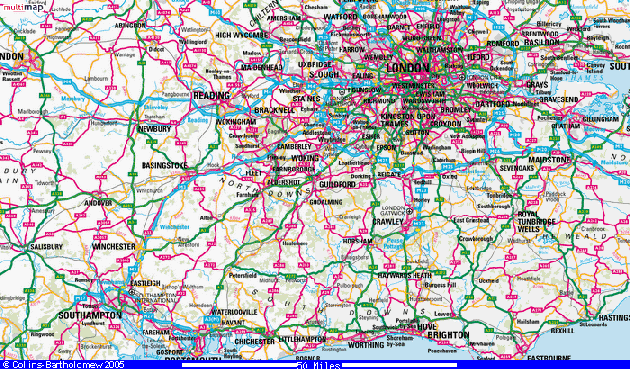
Highlights:
We arrived at the Natural History Museum with assignments in hand. Our study topics were paleontology and general geology, to see Mary Anning's fossils and to
find the hidden treasures within the museum. With study sheets in hand, we were off on the hunt. The museum was housed in a wonderful neo-Gothic building built
between 1863-81 by Alfred Waterhouse. The Victorian Gothic revival took place in London between 1750-1900.
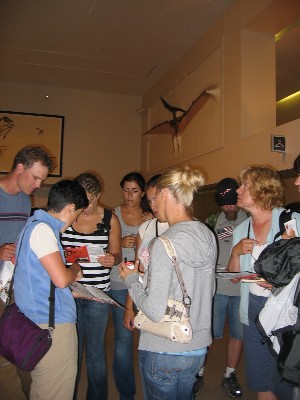 Class visits the London Natural History Museum
Class visits the London Natural History Museum
The museum displays the national collections of fossils, plants, animals and minerals. The gallery that attracts the most attention is the dinosaur
exhibt which displayes fourteen complete skeletons, including a full-size robotic Deinonychus eating a Tenontosaurus.
It was a wonderful museum and well worth the visit.
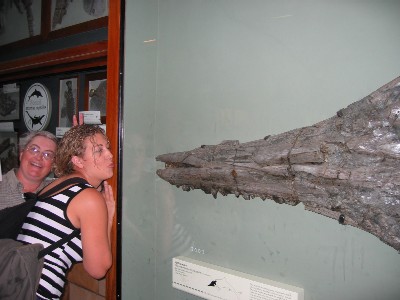 Lisa and Cheryl--having fun with fossils
Lisa and Cheryl--having fun with fossils
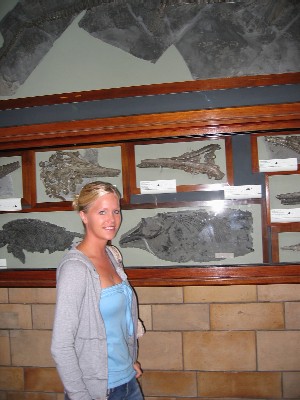 Jenny at the Natural History Museum
Jenny at the Natural History Museum
After the Natural History Museum, many of us visited the Victoria and Albert Museum. It has one of the greatest decorative-arts collections in the world. They
have on display everything from the quintessential "little black dress" to medieval treasures such as early-English Gloucester Candlesticks, to unique embroidery made
in England in the early 14th century. The museum also has the largest collection of Renaissance sculpture outside of Italy, a 16th-century collection of Neptune with Triton in marble, cartoons
by Raphael, the greatest collection of Indian art outside India, as well as Chinese and Japanese galleries. This was another truly wonderful museum.
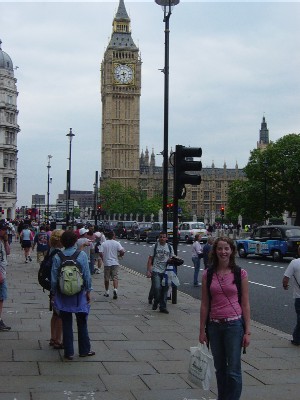 Brienna, Liz and Kathy--and Big Ben
Brienna, Liz and Kathy--and Big Ben
By this time the class was beginning to scatter in all directions. On many student's agenda was a visit the main attractions such as Big Ben, the Tower of London,
London Bridge, Buckingham Palace and the changing of the guards. And, of course, riding a red double-decker bus was mandatory before going home. Another
important and fun trip was to visit Harrods and try sampling the amazing selection of food in their deli.
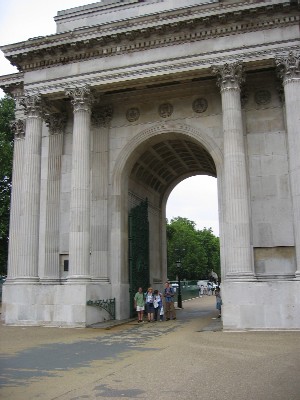 Class under the Marble Arch in London
Class under the Marble Arch in London
London was a wonderful side trip and everyone made it back to Oxford that evening for a good night's sleep and more expoloration the following day. We all came back from London
with great stories of the city. Many of us would return to London after our class trip was finished and continue exploring because there was so much to see!

No trip to England is complete without a visit to one of their red phone booths--Heidi and Lisa
Links to Related Projects:
Mary Anning: Paleontology's Enigmatic First Lady. By Raquel Eriz
The Great Fire of London and the Reconstruction. By Heidi Palermo
Holy Architecture!: Cathedrals, Abbeys, and Parish Churches of Southwest England. By Lisa Green
Geology, Landscapes, and Land Use of Dorset and East Devon. By Angus Leger
Home

 Class visits the London Natural History Museum
Class visits the London Natural History Museum Lisa and Cheryl--having fun with fossils
Lisa and Cheryl--having fun with fossils Jenny at the Natural History Museum
Jenny at the Natural History Museum Brienna, Liz and Kathy--and Big Ben
Brienna, Liz and Kathy--and Big Ben Class under the Marble Arch in London
Class under the Marble Arch in London